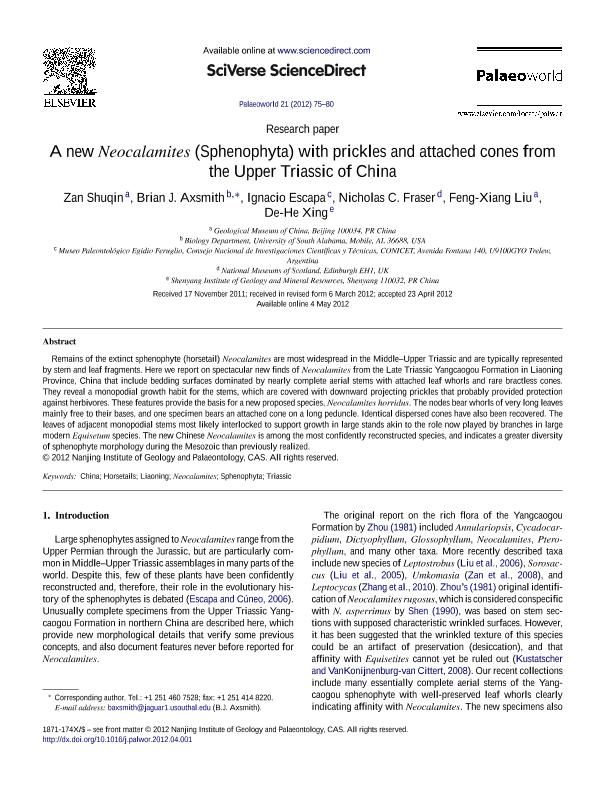Mostrar el registro sencillo del ítem
dc.contributor.author
Zan, Shuqin
dc.contributor.author
Axsmith, Brian J.
dc.contributor.author
Escapa, Ignacio Hernán

dc.contributor.author
Fraser, Nicholas
dc.contributor.author
Liu, Feng Xiang
dc.contributor.author
Xing, De-He
dc.date.available
2023-04-25T10:58:14Z
dc.date.issued
2012-04
dc.identifier.citation
Zan, Shuqin; Axsmith, Brian J.; Escapa, Ignacio Hernán; Fraser, Nicholas; Liu, Feng Xiang; et al.; A new Neocalamites (Sphenophyta) with prickles and attached cones from the Upper Triassic of China; Elsevier; Palaeoworld; 21; 2; 4-2012; 75-80
dc.identifier.issn
1871-174X
dc.identifier.uri
http://hdl.handle.net/11336/195204
dc.description.abstract
Remains of the extinct sphenophyte (horsetail) . Neocalamites are most widespread in the Middle-Upper Triassic and are typically represented by stem and leaf fragments. Here we report on spectacular new finds of . Neocalamites from the Late Triassic Yangcaogou Formation in Liaoning Province, China that include bedding surfaces dominated by nearly complete aerial stems with attached leaf whorls and rare bractless cones. They reveal a monopodial growth habit for the stems, which are covered with downward projecting prickles that probably provided protection against herbivores. These features provide the basis for a new proposed species, . Neocalamites horridus. The nodes bear whorls of very long leaves mainly free to their bases, and one specimen bears an attached cone on a long peduncle. Identical dispersed cones have also been recovered. The leaves of adjacent monopodial stems most likely interlocked to support growth in large stands akin to the role now played by branches in large modern . Equisetum species. The new Chinese . Neocalamites is among the most confidently reconstructed species, and indicates a greater diversity of sphenophyte morphology during the Mesozoic than previously realized.
dc.format
application/pdf
dc.language.iso
eng
dc.publisher
Elsevier

dc.rights
info:eu-repo/semantics/openAccess
dc.rights.uri
https://creativecommons.org/licenses/by-nc-sa/2.5/ar/
dc.subject
CHINA
dc.subject
HORSETAILS
dc.subject
LIAONING
dc.subject
NEOCALAMITES
dc.subject
SPHENOPHYTA
dc.subject
TRIASSIC
dc.subject.classification
Paleontología

dc.subject.classification
Ciencias de la Tierra y relacionadas con el Medio Ambiente

dc.subject.classification
CIENCIAS NATURALES Y EXACTAS

dc.title
A new Neocalamites (Sphenophyta) with prickles and attached cones from the Upper Triassic of China
dc.type
info:eu-repo/semantics/article
dc.type
info:ar-repo/semantics/artículo
dc.type
info:eu-repo/semantics/publishedVersion
dc.date.updated
2023-04-24T13:00:24Z
dc.journal.volume
21
dc.journal.number
2
dc.journal.pagination
75-80
dc.journal.pais
Países Bajos

dc.journal.ciudad
Amsterdan
dc.description.fil
Fil: Zan, Shuqin. Geological Museum Of China; China
dc.description.fil
Fil: Axsmith, Brian J.. University of Alabama at Birmingahm; Estados Unidos
dc.description.fil
Fil: Escapa, Ignacio Hernán. Museo Paleontológico Egidio Feruglio; Argentina. Consejo Nacional de Investigaciones Científicas y Técnicas; Argentina
dc.description.fil
Fil: Fraser, Nicholas. National Museum Of Scotland; Reino Unido
dc.description.fil
Fil: Liu, Feng Xiang. Geological Museum Of China; China
dc.description.fil
Fil: Xing, De-He. Shenyang Institute Of Geology And Mineral Resources; China
dc.journal.title
Palaeoworld
dc.relation.alternativeid
info:eu-repo/semantics/altIdentifier/url/https://www.sciencedirect.com/science/article/pii/S1871174X12000212
dc.relation.alternativeid
info:eu-repo/semantics/altIdentifier/doi/http://dx.doi.org/10.1016/j.palwor.2012.04.001
Archivos asociados
